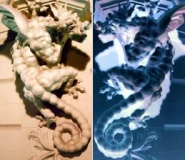Speaker
Sarben Sarkar
(King's College London)
Description
Neutral meson two-particle flavour entangled states of EPR type are produced in meson factories. Breakdown of CPT invariance allows a modified entanglement. Such a change has been called the omega effect. Models involving spontaneous breakdown of Lorentz and CPT do not give rise to such an entanglement. There is another route which can lead to the lack of a well defined CPT operator based on non-unitary evolution owing to decoherence induced by space-time foam. We will show that the omega effect is not an automatic consequence of space-time foam although it can be generated in a model. Two classes of semi-microscopic theoretical models of stochastic space-time foam in quantum gravity are discussed. Although the first class of models deals with a specific model of foam, initially constructed in the context of non-critical (Liouville) string theory involving D-particle solitons, it will be viewed here in the more general context of effective quantum-gravity models. The relevant Hamiltonian perturbation, describing the interaction of the meson with the foam medium, consists of off-diagonal stochastic metric fluctuations, connecting distinct mass eigenstates (or the appropriate generalisation thereof in the case of K-mesons); the perturbation is proportional to the relevant momentum transfer (along the direction of motion of the meson pair). There are two kinds of CPT-violating effects in this case, which can be experimentally
disentangled: one (termed ``$\omega$-effect'') is associated with the failure of the indistinguishability between the neutral meson and its antiparticle, and affects the entanglement properties of the initial state of the two-meson system; the second effect is generated by the time evolution of the system in the medium of the space-time foam, and can result in time-dependent contributions of the $\omega$-effect type in the time profile of the two meson state. Estimates of both effects are given, which show that, at least in certain models, such effects may not be far from the sensitivity of experimental facilities available currently or in the near future. The other class of quantum gravity models involves a medium of gravitational fluctuations which behaves like a ``thermal bath''. In this model both of the above-mentioned intrinsic CPT violation effects are not valid even after exercising a total freedom in the choice of the state of the bath.
Author
Sarben Sarkar
(King's College London)
